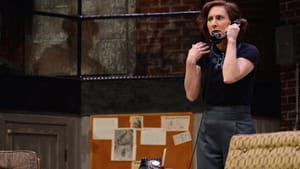Stay in the Loop
BSR publishes on a weekly schedule, with an email newsletter every Wednesday and Thursday morning. There’s no paywall, and subscribing is always free.
Enjoy being afraid in the dark
'Wait Until Dark' at the University of Delaware

The stage thriller was long ago overtaken by film thrillers. Not only are stage thrillers rarely produced, but many of the best (Sleuth, Deathtrap, many Agatha Christie plays) have been made into films. So too was Frederick Knott’s 1966 hit Wait Until Dark, filmed in ’67 starring Audrey Hepburn. As the Resident Ensemble Players at the University of Delaware revival shows, it still works on stage.
Jeffrey Hatcher’s “adaptation” credit is difficult to fathom: a few years ago, he moved the action from the mid-’60s to the mid-’40s and streamlined the script a bit, especially at the end. He changed heroin (the original McGuffin) into diamonds. But the play’s essential aspects — the ones that make it such a unique and nifty thriller — are all Knott’s. (Write your own play, Jeff!)
A unique heroine
Plucky Susan (Deena Burke) is learning to function without her sight, relying on husband Sam’s (Jeffrey C. Hawkins) determined assistance and the less enthusiastic support of teenage neighbor Gloria (Pratigya Paudel, a UD undergrad). Sam was slipped a doll containing contraband by a plane seatmate, and some bad guys arrive to collect it.
Rarely in the ’60s — or today — is a leading female character an equal in a story’s physical action, and not just a victim. It’s especially unlikely when the character is also handicapped. Susan’s knowledge of her Greenwich Village basement apartment (impressively realized by designer Stefanie Hansen) and her growing trust of her other senses help her make a stand, albeit with more than a few gasp-out-loud surprises.
Burke’s upbeat Susan is not only convincingly blind, but expresses Susan’s frustration and self-doubt well too: she’s been sightless for less than a year, and feels helpless.
Thrills and blunders
Lee E. Ernst oozes evil as Roat, who hides his psychopathic brutality with an effete mildness and also slyly plays other characters in his elaborate plan. Stephen Pelinski and Mic Matarrese play men who may or may not befriend Susan — I certainly won’t tell.
The set-up is ingenious, and director Michael Gotch supports it by turning off all the theater lights legally possible when Susan smartly douses her apartment lights to equalize conditions for her climactic showdown with Roat. As long as people keep their damn cell phones off, the only light in the entire theater is the faint green glow of a few exit signs. This easy trick puts us right in the room with them: blind along with Susan and, to his surprise, a ruthless killer.
Then Gotch blunts the thrills by allowing sound designer Barry Funderburg’s dully generic film underscoring to crash scary moments. In movies, this familiar convention works, though it’s usually overdone and unimaginative; on stage, it feels intrusive and manipulative. He succeeds with subtle rumbling bass sounds that provide eerie, almost imperceptible undertone as suspense grows, and is also very specific about the noises appliances make. But he too seldom allows good old realistic silence to do what it does so well, especially in the dark. We should be holding our breath with Susan.
A brief rant about film
I have this same complaint about movie scores: why does every chase scene have to be fueled with high-octane rock music? Some movies feel like the cops or crooks stick in the “Chase Scene” CD when the pursuit starts, which is so ridiculous that Family Guy often mocks it. I once saw a film — not made in Hollywood, of course, but in France — in which a police foot chase through a subway station and onto the street had no thumping music blaring through it. The quiet desperation conveyed by the juxtaposition of city sounds and the running men gasping for air was amazing, and I realized that no film or TV show had ever allowed me this simple experience before. Turn off the sound in a chase scene some time; I guarantee it will feel very different, and probably better.
Back to plays
REP fulfills the play’s technical requirements — which show Susan fighting back not with cheap superwoman strength, but ingenuity and science — believably and with flair. Wait Until Dark still has legs, and makes a case for the stage thriller’s return.
Those seeking more should check out Hedgerow Theatre artistic director Jared Reed’s adaptation of Agatha Christie’s novel The Mysterious Affair at Styles (March 19 – May 8), featuring Belgian detective Hercule Poirot, who appears in 33 novels and 50 stories but only one play (Black Coffee). Some of Martin McDonagh’s plays, like The Lieutenant of Inishmore, certainly apply. But are there any recent American thrillers out there?
What, When, Where
Wait Until Dark by Frederick Knott, adapted by Jeffrey Hatcher, directed by Michael Gotch. Resident Ensemble Players production through February 6 at Thompson Theatre, Roselle Center for the Arts, 11 Orchard Rd., University of Delaware, Newark, DE. 302-831-2204, rep.udel.edu
Sign up for our newsletter
All of the week's new articles, all in one place. Sign up for the free weekly BSR newsletters, and don't miss a conversation.

 Mark Cofta
Mark Cofta